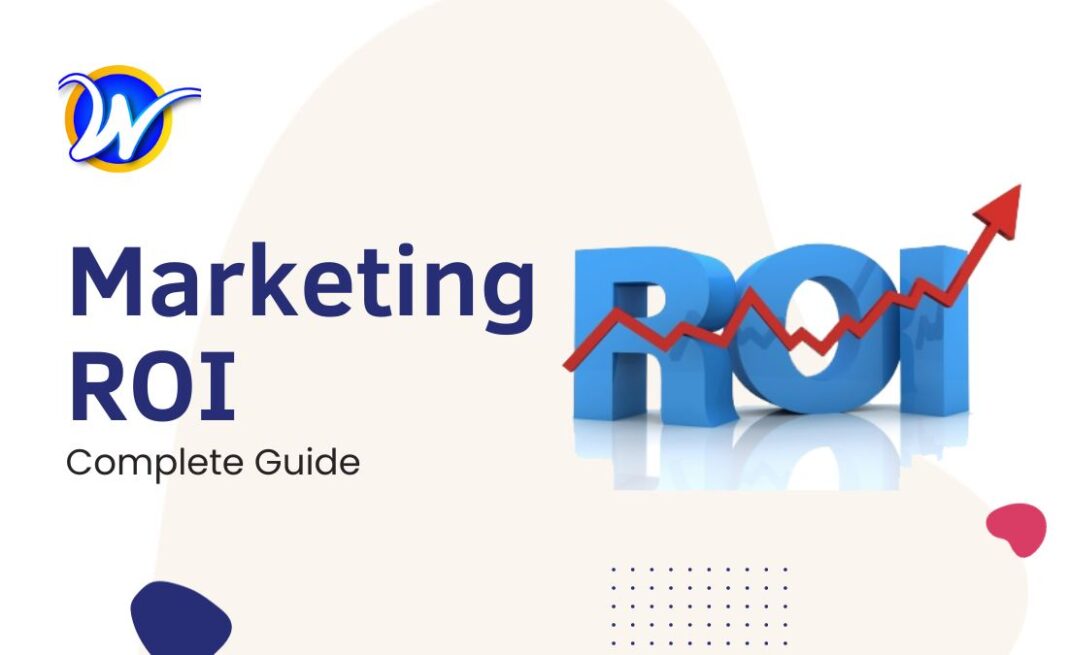In the dynamic landscape of business and marketing, understanding the concept of Marketing ROI (Return on Investment) is paramount. This metric serves as a breadth for businesses, guiding their decisions and strategies by providing valuable perceptions into the effectiveness of their marketing activities.
In this comprehensive guide, we will explain marketing ROI, explore its definition, significance, and how to accurately measure it.
What is Marketing ROI?
Marketing ROI, often referred to as MROI, is a key performance indicator that measures the return generated from a marketing investment relative to its cost. Essentially, it answers the crucial question: “Is the money we are investing in marketing campaigns translating into tangible revenue?”
For businesses, measuring Marketing ROI is like calibrating the effectiveness of their marketing initiatives. It enables marketers to quantify the impact of their efforts, whether it’s through digital campaigns, social media, content creation, or traditional advertising.
The Significance of Measuring Marketing ROI
Understanding Marketing ROI provides numerous benefits that extend beyond mere numerical calculations. It empowers businesses with the ability to:
1. Allocate Resources Effectively
By assessing the ROI of various marketing channels, businesses can allocate their resources to the most impactful strategies. This prevents waste of valuable time and money on efforts that yield minimal returns.
In the world of marketing, not all avenues are equally effective. By calculating ROI, you increase perceptions of which channels are driving the most revenue for your business. This data-driven tactic allows you to channel your efforts and resources into strategies that deliver the maximum returns. Whether it’s investing more in successful social media campaigns or fine-tuning your content marketing strategy, the ability to allocate resources effectively is a game-changer.
2. Demonstrate Value to Stakeholders
For marketing professionals, being able to present a clear ROI is like showcasing a successful scorecard. It helps in justifying marketing budgets, garnering support from stakeholders, and showcasing the tangible value that marketing brings to the organization.
Imagine walking into a boardroom armed with data that demonstrates how your marketing initiatives are directly contributing to the bottom line. By showcasing the ROI, you’re not just showing numbers; you’re narrating a story of how your efforts are making a significant impact on the company’s growth trajectory. This ability to translate marketing efforts into concrete value resonates deeply with stakeholders and opens doors for increased budget allocation and support for future campaigns.
Read Also: Tech Advancements Taking Marketing to the Next Level
3. Optimize Campaigns
Marketing ROI analysis offers insights into which campaigns are performing exceptionally and which need optimization. By identifying successful elements, marketers can replicate winning strategies and refine underperforming ones.
The realm of marketing is an ever-evolving landscape, where continuous improvement is key. With Marketing ROI as your guiding light, you gain a magnifying glass to dissect your campaigns. Evaluating the performance of different strategies lets you find what is working and what is not. Equipped with this information, you can make conversant decisions about adjusting your strategies. It’s not just about boosting successful campaigns; it’s about learning from failures and fine-tuning your approach for the best possible results.
Calculating Marketing ROI
Determine Revenue from Marketing: This involves tracking and attributing revenue generated directly from the marketing campaign. Tools like Google Analytics and CRM systems can help in accurate revenue attribution.
Accurate data collection is the bedrock of calculating Marketing ROI. You need to meticulously track the revenue that can be directly attributed to your marketing efforts. This might involve setting up specific tracking codes, utilizing UTM parameters, or integrating your CRM system with your marketing platforms. With accurate revenue data in hand, you’re laying the foundation for an accurate ROI calculation.

Calculate Cost of Marketing: Sum up all the costs associated with the marketing campaign. This includes expenses like ad spend, content creation costs, design fees, and overhead costs.
While calculating the cost of marketing might seem straightforward, it’s crucial not to overlook any expenses. Beyond the obvious costs like ad spend, remember to include the intricacies—design costs, copywriting fees, costs of running A/B tests, and even the man-hours invested by your team. A complete cost evaluation ensures that your ROI calculation is as precise as possible.
Plug into the Formula: Minus the Cost of Marketing from the returns from Marketing, and then divide by the Cost of Marketing.
Now comes the moment of truth. Plug the values into the ROI formula, and you have a percentage that counts the success of your marketing energies. A positive ROI indicates that your campaigns are generating more revenue than they’re costing you. A negative ROI, on the other hand, might signal the need for strategic adjustments.
Factors Influencing Marketing ROI
While we promised not to delve into a list of factors, it’s essential to mention a few key variables that impact Marketing ROI:
1. Target Audience
Relevance matters. If your marketing efforts aren’t reaching the right audience, your ROI will suffer. Understanding your audience’s preferences and behaviors is crucial for success.
Identifying your target audience isn’t just about demographics; it’s about understanding their pain points, aspirations, and preferences. Tailoring your marketing strategies to resonate with your audience’s needs significantly enhances the likelihood of a higher ROI. Whether it’s crafting personalized email campaigns or curating content that speaks directly to their challenges, audience-focused marketing is a surefire way to boost your ROI.
2. Quality of Content
Compelling, engaging content resonates with audiences. Valuable content drives customer engagement and conversions, significantly influencing ROI.
Content is the backbone of modern marketing. It’s the vehicle through which you communicate your brand’s message and value proposition. Investing in high-quality, valuable content pays dividends in terms of engagement, shares, and conversions. From thought-provoking blog posts to engaging social media content, every piece of content is an opportunity to capture your audience’s attention and drive them towards action, ultimately impacting your ROI.
3. Consistency and Timing
Consistent messaging across various touchpoints enhances brand recall and loyalty. Timing also plays a role – reaching the audience at the right moment can make all the difference.
Imagine seeing a brand’s message across various platforms, each time reinforcing a consistent narrative. This level of brand consistency builds trust and familiarity with your audience, increasing the likelihood of them converting. Additionally, timing plays a pivotal role. Being in the right place at the right time—whether it’s sending out an email during peak engagement hours or launching a product during a relevant season—can amplify your ROI significantly.
4. Attribution
Accurate attribution of conversions to the correct marketing channels is vital. Multi-touch attribution models provide a more realistic view of ROI.
In the complex landscape of modern marketing, it’s rare for a customer to convert after a single touchpoint. Multiple interactions often play a role in their decision-making process. Accurate attribution involves tracking each touchpoint and assigning the appropriate weight to each in terms of conversion. Multi-touch attribution models, whether linear, U-shaped, or time decay, offer a more realistic depiction of how your marketing efforts are contributing to conversions, leading to a more accurate ROI calculation.
Conclusion
In the grand symphony of business, Marketing ROI conducts a harmonious melody. It’s not just about numbers; it’s about understanding the impact of marketing on your organization’s growth. By comprehending Marketing ROI and its nuances, businesses can refine their strategies, maximize their returns, and pave the way for sustainable success. Remember, the journey to a higher Marketing ROI begins with understanding its definition, significance, and accurate measurement.



